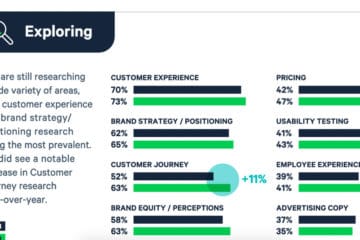Monitoring Your Brand with a Brand Tracking Study
Unlike some other marketing activities, branding can be difficult to measure. It is obvious strong brands inspire customer loyalty. But how can you know how strong your brand is, what factors are helping or hurting it, and how that impacts your business? Monitoring your brand takes some work, but it is doable. Let’s discuss some basics of setting up a brand tracking study.
What are we tracking?
On its face, Brand Strength is an ambiguous concept. It helps to break it down into parts to understand specifically what we are trying to know:
- Awareness: At a base level, do consumers know your brand exists? This can also be broken down further:
- Unaided awareness: when asked to list brands in your category, consumers recall your brand name spontaneously
- Aided awareness: when presented with a list of brands in your space, consumers will check yours off as one they know of
- Favorability: Do consumers have a favorable or unfavorable impression of your brand? Often this is asked on a scale to determine how strongly they feel
- Brand attributes: How strongly do consumers associate chosen attributes with your brand? The specific ones chosen vary by category or business. Some examples might be:
- Valuable
- Durable
- Trustworthy
- Cool
- User-friendly
- Stylish
- Engagement: In what ways have consumers interacted with your brand? This can be framed in frequency (how many times or how often) or simple yes/no (have you ever…?). For example:
- Seen an ad
- Shopped for
- Researched online
- Purchased
- Re-purchased
- Shared
- Recommended
- Recommendation: How likely are customers to recommend your brand to others?
This is not an exhaustive list, but it covers many of the major points you might research.
Who do you Survey?
You will need a panel, ideally made up of some customers and some non-customers. Your customer email list can serve as a good starting point for the former. For the latter, you will likely need to enlist a third party to help recruit. Depending on your company and the scope of your survey, various tiers of providers can sell access to their survey panels. Qualtrics and Survey Monkey are two of the better known options at the smaller end. There are also companies with huge panels for major projects.
How Do We Use This data for Monitoring Your Brand?
Think of brand tracking as one data point in assessing the overall health of your business. Along with things like cash flow, sales, margin, and market share, it helps track how your situation is going over time.
Depending on your resources, it can also be wise to track all or some of these attributes about your competitors, to understand where you fit in the category.
When you run a study initially, you will likely uncover some interesting tidbits about consumer perceptions. These will likely reveal some strengths and possibly some weaknesses. Depending on what they are, it may be time adjust the brand strategy, pricing, distribution, advertising, etc.
Re-running the study over time can help you get a sense of how you are performing against these baselines. This is good to know for its own sake (“Trust is up 14%!”), but even better when correlated with other business KPI’s, to test which brand attributes truly matter to consumers in your category.
So Let’s Go!
Brand tracking is valuable in taking some of the guess work out of building your brand. It shows what the greatest needs are, and provides a framework for assessing how you are moving those needles over time. Even better, it can help correlate branding activities with the main goal of growing your business.
If you would like to discuss more about the process of brand tracking, or work together on monitoring your brand, let me know.



0 Comments